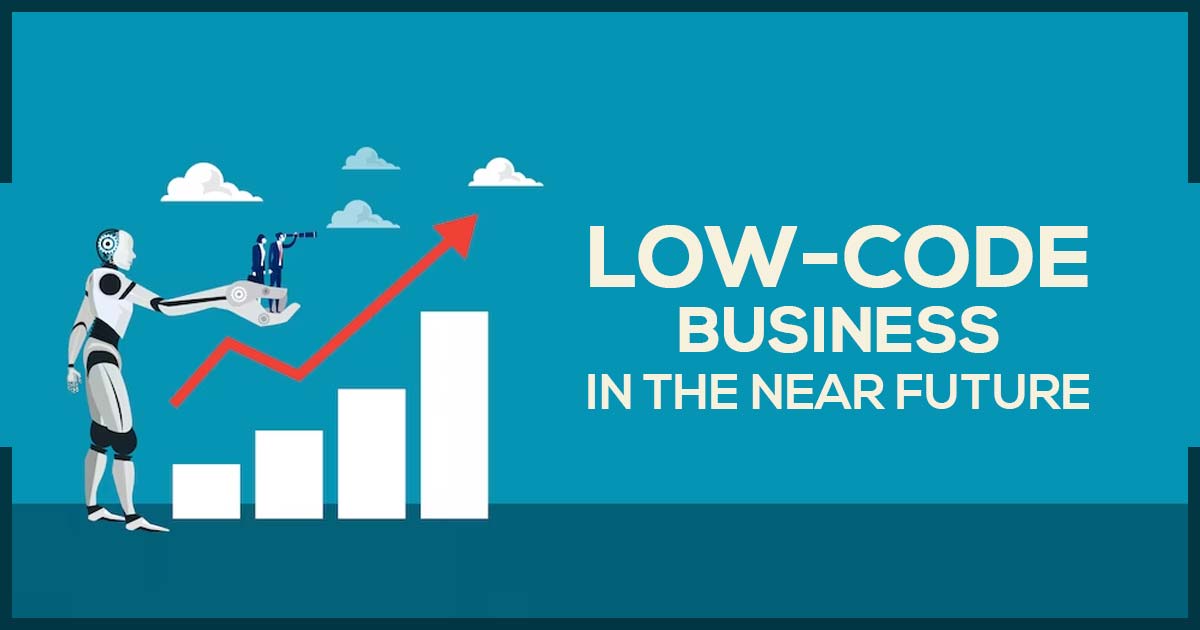
The low-code business in the software sector is expanding quickly. 70% of newly created business apps by 2025 will use low-code or no-code technology.
We witness new vendors entering the market each year as low code becomes more widely used. In this blog article, we’ll look at a few low-code statistics and flavours to assist you to select the best option for your company’s needs while navigating the noise of this very competitive business market.
What is the Reason for the Sudden Low-code Business Rise?
Low-code platforms eliminate the need for manual coding and increase developer productivity by allowing business users and professional developers to build applications using visual programming.
So it should come as no surprise that low-code is growing more popular at a time when client expectations are continuously shifting, businesses are searching for solutions that can allow hybrid work, and the level of competition is increasing.
Three trends leading to low-code adoption are specified below:
Digitization of Information Technology
In an organization, 41% of employees are “business technologists,” or collaborators outside of IT departments who develop technology or analytics skills for their own use. Since the majority of them do not have traditional programming experience, they rely heavily on low-code and no-code technologies to produce the solutions they require.
Automatized Systems
Hyperautomation refers to the orchestration of numerous upgraded technologies that enable end-to-end business process automation. Low code, in conjunction with robotic process automation technologies, artificial intelligence, and machine learning, has appeared as a critical technology option for enabling successful hyper-automation programs.
Combined Businesses
A composable business is one where a company is made up of interchangeable building elements that may be rearranged and reoriented as required in response to internal or external influences. Composable enterprises make use of a framework that allows them to create apps by assembling and mixing components. Low-code technology plays an important role in fostering component-based design and reusability of services, features, and capabilities as organizations embrace a composable psyche.
What is the Size of The Low-code Business?
Low-code platforms are not new; in recent years, there has been an increase in demand for the same. For example, the number of low-code providers expanded from 40 to 60 between 2016 and 2018. According to sources, the number has now risen to more than 200.
To gain the benefits of low-code platforms, organizations must first choose the proper vendor, one that can function as a real digital transformation partner and allow them to innovate as the business demands.
Making that choice, however, might be difficult due to the vast range of low-code capabilities.
Learning The Low-code Business Landscape
Low-code platforms are not all created equal, much like any other technology, and not all of them are appropriate for the same use cases.
Three factors can aid in your understanding of the low-code business if you’re currently assessing low-code for a specific project:
- Who is the targeted user of the platform?
- What functions and features does the platform include?
- What use cases does the platform address?
In light of this, there are three major groups into which the low-code business may be divided:
#1. General Low-code
Who is the targeted user of the platform?
A higher level of code abstraction would get provided by the low-code platform in this division in order to make the businesses stronger or citizen developers, in short for developing the apps the users who are not from the development background shall be required to use it daily.
What Operations and Features Does the Platform Contain?
The same comprises exclusively “basic” low-code capabilities like model-driven or graphical programming approaches with scripting.
The simpler tools are also classified as no-code since they allow you to create small apps entirely visually without any programming experience.
What use Cases will the Platform Count?
In order to attain the departmental level requirements the regular low code platforms would be designed such as vacation requests or an approval routing application.
#2. Low-code for Enterprises
Who is the Targeted User of the Platform?
Enterprise low-code platforms are primarily aimed at professional developers. Some may enable business users to build simple process apps and transfer them to IT for deployment outside of their departments.
What Operations and Features Does the Platform Contain?
In comparison to “regular” low-code platforms meant for developing simpler apps, process automation-focused low-code platforms include additional bells and whistles. In order to address basic to complicated tasks, it incorporates more updated low-code capabilities.
What Use Cases Does the Platform Count?
This category addresses the requirement to digitalize workflows across the company, from business operations to case management.
In other words, these systems are ideal for managing any problem that can be automated and workflow, such as the approval procedure for expenses, claims processing, shipping, and distribution.
Unfortunately, processes cannot resolve every issue. As a result, for customer experience use cases that need additional personalization, these systems tend to fall short.
#3. Low-code for Higher Performance
What Targeted User Does the Platforms Have?
The high-performance low-code platform is primarily intended for professional developers who require modern and advanced low-code solutions. However, it also offers organizations the option to adopt a fusion team approach, which encourages the involvement of business stakeholders in the development process by providing visual capabilities, guardrails, and governance.
What the Platform Functions and Features
The high-performance low-code platform provides comprehensive support in end-to-end application development and updates. It eliminates the need for additional licensing, scalability concerns, and data complications when transitioning from departmental applications to enterprise-wide software.
This platform sets itself apart from other categories through the following four key characteristics:
Full-stack Development Software
Development teams can build various types of software solutions, including user interfaces, frontends, backends, and automation. Most importantly it does not even require advanced coding skills. They can leverage the platform’s pre-built capabilities or extend its functionalities using custom code to make sure they never hit limitations.
Intuitive Agility
High-performance low-code offers features such as reusable components, connectors, UI components, and integrated DevOps (or compatibility with existing DevOps tools). These capabilities enable the development of pixel-perfect, robust, responsive, and AI-driven consumer applications, internal apps, portals, and core systems, allowing speedy adaptation as needed.
Dedicated To Security
This platform enhances low-code security by embedding security mechanisms and automated validations. Additionally, it creates source code that can be scanned for security vulnerabilities and issues, providing an extra layer of protection.
Colossal Dimension:
Applications built using high-performance low-code platforms can seamlessly expand from department-level deployments with a limited number of users to handling millions of simultaneous users, all without compromising speed and performance. The platform’s advanced visual, model-driven development tools, along with elite-level continuous integration and continuous delivery (CI/CD) practices, transform development teams into a cloud-native innovation factory.
Use Cases of the Platform
High-performance low-code is designed to address complex, strategic, and mission-critical consumer and internal software requirements. In other words, organizations can build any software solution they need without the complexities associated with traditional development or the limitations of simpler low-code platforms.
What Shall be the Correct Low-Code Platform for You?
It always relies on your demands; this category doesn’t imply that one kind of low-code platform is superior to another.
The first category is sufficient if all you want to do is enable your line of business to create simpler applications. However, you should search for high-performance low-code if you’re looking for a solution to help your digital transformation projects.
Don’t jump into something hastily, either. High-performance low-code is a sure bet since it’s always feasible that someone will wish to make that simple app or automated procedure accessible to everyone.
Who Furnishes High-Performance Low-code Platforms?
SDMT adds abstraction not just to the development process through visual programming, but also to the whole CI/CD cycle. Your teams may accelerate development tremendously by automating chores that take significant development time, thanks to AI and automation.
The developers would provide the serious apps with effective productivity at a faster pace which removes the waste and overhead so that the professional developers could carry on with the creative business of designing and placing the uniqueness.
SDMT low-code no-code platform is leading with the highest score for the most appropriate use cases for businesses today, namely:
- Transactional applications for B2C use cases
- Business workflows and systems integration
- Back-office apps with pro and citizen developers








